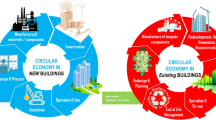
Overview
- Brings together scholars with different backgrounds and professionals
- Provides cutting-edge information on circular economy in the built environment
- Written by experts in the field
- This book is open access, which means that you have free and unlimited access
Part of the book series: Springer Tracts in Civil Engineering (SPRTRCIENG)
Buy print copy
Tax calculation will be finalised at checkout
About this book
This open access book summarizes the research being pursued as part of the COST Action CA21103 titled "Implementation of Circular Economy in the Built Environment" (Circular B), which aims to define the methodology to develop a common circularity framework for inclusive application and assessment in new and existing buildings to support decision-making for all value chain stakeholders and appraise the implementation level of the European Circular Economy Action Plan (CEAP). The Action is increasingly gaining interest worldwide, bringing multidisciplinary young and experienced researchers together to share the latest studies and develop new knowledge. Consisting of 17 chapters corresponding to the conference themes, the book analyses and discusses topics such as Circular Economy (CE) best practices, design strategies for circular buildings, circular materials and products, adaptive reuse of existing buildings, recovery and reuse of salvaged materials and products, case studies of current applications and trends, barriers against CE implementation in buildings, efficient waste and circular resource management, circular lifecycle management and decision making, stakeholders relationships, CE supporting policies and barriers, circular business models, criteria, KPIs and assessment models for circular buildings, CE criteria in sustainability frameworks, digitalization and BIM for enhanced circularity of buildings and building materials, and standardization of CE definitions in buildings.
Similar content being viewed by others
Keywords
Table of contents (35 chapters)
-
Front Matter
-
Circular Economy Best Practices in the Built Environment
-
Front Matter
-
-
Design Strategies and Tools for Circular Buildings
-
Front Matter
-
-
Circular Materials and Building Products
-
Front Matter
-
-
Adaptive Reuse of Existing Buildings
-
Front Matter
-
-
Recovery and Reuse of Salvaged Building Materials and Products from Existing Structures
-
Front Matter
-
-
Current Applications and Trends—Case Studies
-
Front Matter
-
Editors and Affiliations
Bibliographic Information
Book Title: Creating a Roadmap Towards Circularity in the Built Environment
Editors: Luís Bragança, Meri Cvetkovska, Rand Askar, Viorel Ungureanu
Series Title: Springer Tracts in Civil Engineering
DOI: https://doi.org/10.1007/978-3-031-45980-1
Publisher: Springer Cham
eBook Packages: Engineering, Engineering (R0)
Copyright Information: The Editor(s) (if applicable) and The Author(s) 2024
Hardcover ISBN: 978-3-031-45979-5Published: 07 December 2023
Softcover ISBN: 978-3-031-45982-5Published: 07 December 2023
eBook ISBN: 978-3-031-45980-1Published: 06 December 2023
Series ISSN: 2366-259X
Series E-ISSN: 2366-2603
Edition Number: 1
Number of Pages: IX, 444
Number of Illustrations: 45 b/w illustrations, 90 illustrations in colour
Topics: Sustainable Architecture/Green Buildings, Sustainable Development, Computer Applications, Construction Management, Environmental Economics



